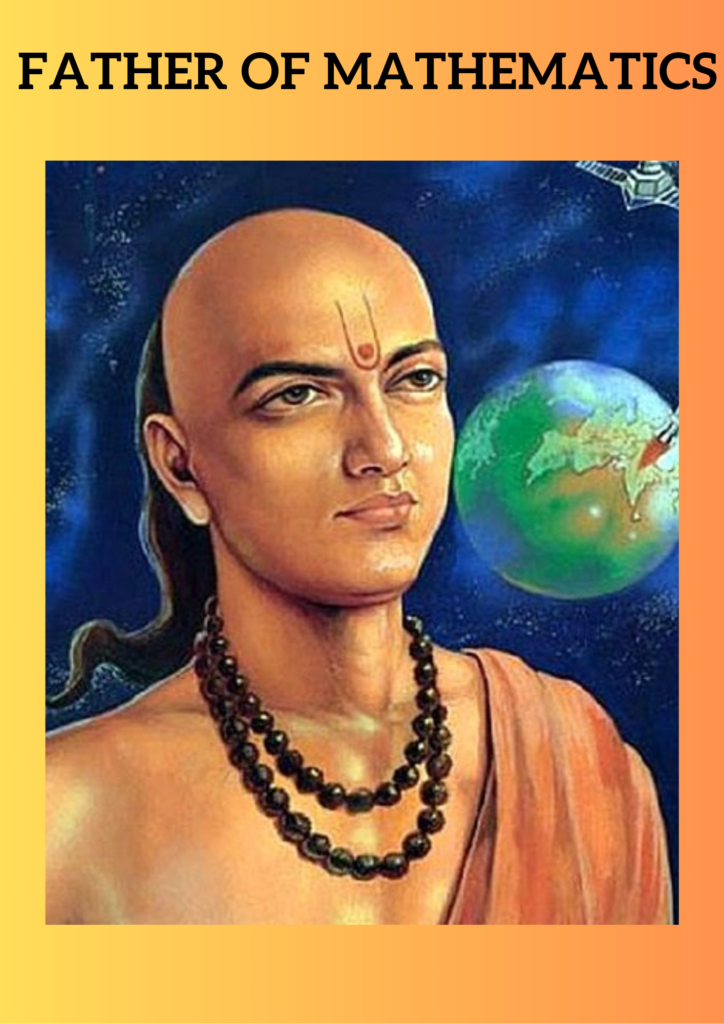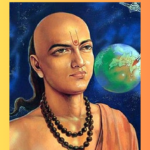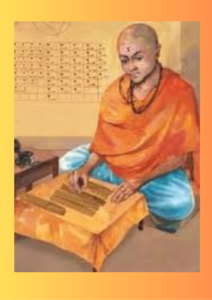Discover the enchanting world of mathematics, from its historical roots to the profound contributions of Indian mathematicians. Explore the sweetness and logic of mathematics that shapes our lives.
Introduction
In the tapestry of human knowledge, mathematics stands as a vibrant thread, weaving through the fabric of existence with precision and elegance. Its allure lies not only in its practical applications but also in its innate beauty and logical richness. In this blog, we embark on a journey to unravel the enchanting world of mathematics, exploring its historical origins, the legacy of Indian mathematicians, and the enduring impact of mathematical inquiry on our lives.

The Father of Mathematics: Aryabhata

Aryabhata: Pioneer of Indian Mathematics
Early Life and Contributions
Born in 476 CE in the ancient kingdom of Magadha, Aryabhata emerged as a beacon of mathematical brilliance during the Gupta Empire. His seminal work, Aryabhatiya, stands as a testament to his unparalleled intellect and visionary insights into the cosmos. Aryabhata’s treatise encompassed groundbreaking discoveries in algebra, trigonometry, and astronomy, laying the foundation for centuries of mathematical inquiry.
Aryabhata’s mathematical prowess extended beyond theoretical formulations to practical applications, such as accurately predicting eclipses and calculating the circumference of the Earth. His methodical approach to mathematics revolutionized Indian scholarship, inspiring a new wave of mathematical exploration and innovation.
Legacy and Influence
The legacy of Aryabhata transcends the confines of time and space, resonating across generations of mathematicians and astronomers. His innovative methods and profound insights continue to shape our understanding of the universe, underscoring the timeless relevance of his contributions to mathematical knowledge. Aryabhata’s enduring influence serves as a testament to the enduring power of human curiosity and the boundless potential of mathematical inquiry.
Some Indian Mathematicians from Ancient Times
Exploring Ancient Mathematical Pioneers
Brahmagupta: The Master Astronomer

Brahmagupta: Architect of Mathematical Formulas
Contributions to Algebra
Brahmagupta, a contemporary of Aryabhata, made significant contributions to the field of algebra through his seminal work, Brāhmasphuṭasiddhānta. His treatise introduced revolutionary concepts, including the formulation of quadratic equations and solutions for indeterminate equations. Brahmagupta’s mathematical formulas laid the groundwork for future advancements in algebra, shaping the trajectory of mathematical inquiry for centuries to come.
Astronomical Discoveries
In addition to his achievements in algebra, Brahmagupta made significant contributions to astronomy, elucidating the principles of celestial mechanics and planetary motion. His astronomical observations provided invaluable insights into the dynamics of the solar system, guiding navigators and astronomers in their quest to unravel the mysteries of the cosmos.
Bhaskara II: The Genius Geometer

Bhaskara II: Maestro of Geometry
Works in Geometry
Bhaskara II, a renowned mathematician and astronomer of the 12th century, made indelible contributions to the field of geometry through his magnum opus, Siddhanta Shiromani. His treatise explored the principles of calculus, centuries before its formalization in the Western world, and provided groundbreaking solutions to geometric problems that continue to inspire mathematicians today.
Astronomical Achievements
In addition to his advancements in geometry, Bhaskara II made significant contributions to astronomy through his work, Goladhyaya. His meticulous calculations of planetary positions and celestial phenomena were instrumental in guiding navigators and astronomers, enriching our understanding of the cosmos and the interconnectedness of celestial bodies.
Srinivasa Ramanujan

Certainly! Srinivasa Ramanujan, often referred to simply as Ramanujan, was an Indian mathematician who made remarkable contributions to mathematical analysis, number theory, and infinite series. Born on December 22, 1887, in Erode, Tamil Nadu, Ramanujan displayed an extraordinary aptitude for mathematics from a young age, despite lacking formal training.
Journey into Mathematics
Ramanujan’s breakthrough came in 1913 when he independently compiled a notebook of his mathematical discoveries, containing a plethora of groundbreaking ideas and conjectures. Despite receiving little formal education, Ramanujan’s insights captured the attention of prominent mathematicians in India, including S. Narayana Iyer, who recognized his exceptional talent and provided him with the support needed to pursue his mathematical endeavors.
Collaboration with Hardy
In 1913, Ramanujan caught the attention of British mathematician G.H. Hardy, who recognized the profound significance of his work. Invited to study at the University of Cambridge, Ramanujan collaborated with Hardy on numerous mathematical problems, resulting in a series of groundbreaking papers that revolutionized the field of mathematics.
Innovative Ideas
Ramanujan’s contributions to mathematics spanned a wide array of topics, with some of his most innovative ideas including:
Ramanujan Prime: Ramanujan formulated a conjecture regarding the distribution of prime numbers, known as the Ramanujan Prime. His insights into the properties of prime numbers provided valuable insights into number theory and paved the way for further research in this area.
Mock Theta Functions: Ramanujan introduced a class of functions known as mock theta functions, which are a generalization of the ordinary theta functions. These functions played a crucial role in the development of modular forms and their applications in various branches of mathematics.
Ramanujan’s Conjecture: Ramanujan proposed several conjectures in the field of number theory, many of which remain unsolved to this day. One of his most famous conjectures relates to the partition function, which describes the number of ways a positive integer can be expressed as a sum of smaller positive integers.
Infinite Series: Ramanujan’s mastery of infinite series was unparalleled, and he derived numerous remarkable identities and approximations for various mathematical constants, including pi and e. His work in this area laid the foundation for further developments in mathematical analysis and approximation theory.
Legacy
Ramanujan’s contributions to mathematics continue to inspire mathematicians and researchers worldwide, with his work serving as a testament to the power of human intuition and ingenuity. Despite facing numerous challenges, Ramanujan’s indomitable spirit and unwavering dedication to his craft have left an indelible mark on the field of mathematics, earning him a place among the greatest mathematicians of all time.
A Brief Analysis
Unveiling the Brilliance of Indian Mathematicians
Mathematical Innovations
The contributions of Indian mathematicians from ancient times exemplify the spirit of inquiry and innovation that has characterized mathematical scholarship throughout history. From Aryabhata’s pioneering discoveries in astronomy to Brahmagupta’s revolutionary formulations in algebra, Indian mathematicians have continually pushed the boundaries of mathematical knowledge, enriching our understanding of the world and our place within it.
Cultural Significance
Beyond their mathematical achievements, Indian mathematicians have left an indelible mark on cultural narratives and societal values. Their intellectual legacy serves as a source of inspiration for future generations, fostering a culture of curiosity and inquiry that transcends disciplinary boundaries and fosters interdisciplinary collaboration.
Enduring Influence
The enduring influence of Indian mathematicians underscores the timeless relevance of mathematical inquiry and the profound impact it has on human civilization. Their contributions continue to inspire curiosity and innovation, shaping the trajectory of mathematical research and education worldwide. As we reflect on the brilliance of Indian mathematicians from ancient times, we are reminded of the transformative power of human intellect and the boundless potential of mathematical exploration.
FAQs (Frequently Asked Questions)
Who is considered the father of mathematics in India? Aryabhata is widely regarded as the father of mathematics in India due to his groundbreaking contributions to algebra, trigonometry, and astronomy.
What is Aryabhata’s most famous work? Aryabhata’s seminal work, Aryabhatiya, is his most renowned treatise, encompassing profound discoveries in mathematics and astronomy.
How did ancient Indian mathematicians influence modern mathematics? Ancient Indian mathematicians laid the foundation for modern mathematical principles, including algebra, geometry, and calculus, shaping the trajectory of mathematical inquiry worldwide.
What are some notable achievements of Brahmagupta? Brahmagupta’s contributions to algebra and astronomy were instrumental in advancing mathematical knowledge, particularly his formulation of quadratic equations and astronomical observations.
What distinguishes Bhaskara II’s contributions to mathematics? Bhaskara II’s expertise in geometry and astronomy distinguished him as a preeminent mathematician, with his works in Siddhanta Shiromani and Goladhyaya showcasing his unparalleled intellect.
How do Indian mathematicians continue to inspire contemporary scholars? Indian mathematicians’ enduring legacy serves as a beacon of inspiration for contemporary scholars, fostering a spirit of inquiry and innovation in mathematical research and education.
Conclusion
As we reflect on the profound contributions of Indian mathematicians, we are reminded of the timeless pursuit of knowledge that transcends borders and generations. From Aryabhata’s pioneering discoveries to the geometric marvels of Bhaskara II, the legacy of these mathematical luminaries continues to illuminate our path forward, guiding us towards new horizons of understanding.
Boldly embrace the beauty of mathematics, for within its infinite depths lies the essence of life’s greatest mysteries.
Some of the relevant books to learn more about our ancienct vedic mathematics and its importance
-
Vedic Mathematics Made Easy, 2nd Edition By Dhaval Bathia 209/- Rs
The book is popular among the readers for its quick approach to solve tricky problem of mathematics. Utilizing a handful of formulae, Bathia describes how you can tackle complex mathematics with ease. The book is not only helpful for students, but also a good guide for professionals and businessmen as well. The formulae in Vedic mathematics are known as Sutras. The author has penned sixteen important Sutras in teaching the readers on how to utilize them to break complex problems in arithmetic and algebra. The formulae are mainly based on the workings of the human brain. The specialty of the formulae are that they are not like traditional formulae with plenty of theory, thus it does not take time to memories it. The book is also useful for aspirants preparing for competitive exams like CAT, GRE and GMAT.
-
THE ESSENTIALS OF VEDIC MATHEMATICS By Rajesh Kumar Thakur 315/- Rs
The Essentials Of Vedic Mathematics is a book that shows you how to master Vedic mathematics independently, without the help of any expert. Vedic mathematics consists of sixteen sutras and sixteen sub-sutras. It is an ancient technique that can be very beneficial to people even today. The book shows you how to simplify the most basic arithmetic operations and also deal with complex mathematical concepts such as quadratic equations, factorization of cubic equations and much more.
-
Vedic Mathematics (Indian Classics) By Maple Press 119/-Rs
Vedic Mathematics: The Problem Solver contains a list of mental calculation techniques based on the original Vedas written by Maharishi Ved Vyas. It focuses on “Ganita Sutras” which are easier to learn, faster to use and less prone to errors and help develop creativity, logical thinking and intuition. Vedic Mathematics can be used to remove math phobia and can be taught to (school) children as an easy learning material along with other high-speed methods.
-
The Essentials of Vedic Mathematics + Advanced Vedic Mathematics 550/-Rs
The Essentials of Vedic MathematicsAbout The Book The Essentials Of Vedic Mathematics is a book that shows you how to master Vedic mathematics independently, without the help of any expert. Vedic mathematics consists of sixteen sutras and sixteen sub-sutras. It is an ancient technique that can be very beneficial to people even today. The book shows you how to simplify the most basic arithmetic operations and also deal with complex mathematical concepts such as quadratic equations, factorization of cubic equations and much more. Considering that Vedic mathematics is now being used extensively even by those students who are preparing for a range of competitive examinations, it is important that you be able to use this method to your advantage. Vedic Mathematics is now used in preparations for the CAT, SAT, XAT, MAT, banking entrance exams, engineering exams and many other similar competitive examinations. Keeping in mind just how important speed and reasoning are in such exams, the author shows you how to use these concepts to finish your paper quickly and correctly.
